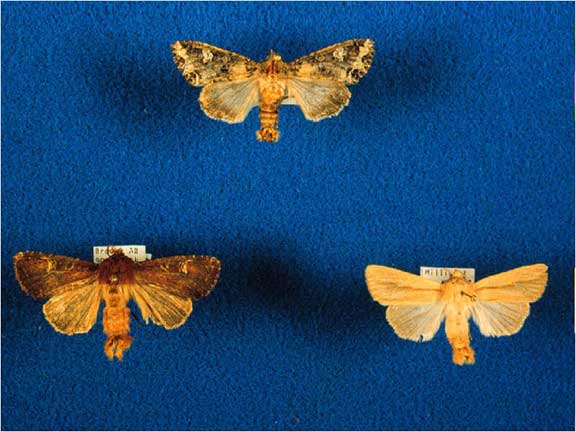| | Monitoring period | Unitraps | Site selection | Insecticide strips | Lures | Non-target moths | Moth collection | Diagnostic guide
Bertha armyworm has been monitored by Alberta Agriculture, Food and Rural Development using pheromone-baited traps since 1985. This year, in cooperation with crop specialists, agricultural fieldmen and industry specialists, we will monitor berthas in over forty counties and municipal districts throughout the canola-growing area of Alberta. Monitoring will be conducted in the Peace River area as well this year, using trap technology from a recently completed research project. The project investigated ways to improve the pheromone monitoring system for bertha armyworm in the Peace so that excessive bumble bee captures can be avoided. All sites are monitored using two traps, spaced one hundred metres apart.
Monitoring Period
The bertha armyworm flight period generally runs for about eight weeks from about the beginning of June through the end of July. Traps are set out by cooperators on a convenient day during the first week of monitoring. Moths are collected on the same day each week. On the last collection day, the traps are taken down.
Unitraps
The "Unitrap" is a 3-piece, moulded plastic trap. We use the all-green model in preference to the yellow, white and green version that we started the program with in 1985. Tests done in 1986 showed the green traps caught fewer bumble bees and other non-target insects than the three-colour trap. The trap requires minimal maintenance (wash prior to storage) and has given almost trouble-free service. We have fitted the traps with a cotter pin to secure the base to the funnel and with holes in the side of the base for securing a piece of insecticide strip to kill trapped insects. Holes have been drilled in the base bottom for water drainage. If you have purchased your own traps, you should make these modifications.
Site Selection
Female bertha armyworm moths are attracted to host plants to lay their eggs (See diagnostic guide). Canola in early bloom is particularly attractive so bertha traps must be placed next to canola fields. Traps are placed along the west edge of a canola field with a north-south road for easy access to the trap. The site should be representative of the surrounding area and at least 1/4 mile from the nearest farm yard so that lights do not compete with trap attraction. Do not select a site that has a terrain feature that would alter airflow around the trap, such as a shelterbelt, high road grade or deep ditch. Mount the traps just inside the field at about three feet off the ground on a sturdy stake.
Insecticide Strips
A small strip of resin impregnated with an insecticide, dichlorvos, is mounted inside the trap to kill trapped insects promptly and so preserve specimen quality. A twist tie secures the resin strip to the inside wall of the trap base. The insecticide remains effective for the flight period and the strip is then discarded.
Lures
Lures are purchased from Phero Tech, the same company that sells the Unitrap. The pink rubber lure contains the sex-attractant chemicals (pheromone) that attract bertha males. Do not handle the lure. Oils from your skin can lessen the lures' effectiveness. Lures are attached to a plastic tie like the ones used to fasten labels to garments. Store the lures in the freezer until you are ready to put the traps out. At that time, insert the tie through the hole in the lid and snap the plastic cap into the hole so that the lure is suspended between the lid and the funnel part of the trap. The lures remain effective for the duration of the flight period. Discard them when the final collection is made.
Non-target Moths
For a number of reasons, non-target ('contaminant') species are also caught (Figure 1), but these can be readily distinguished from bertha armyworm moths with a little practice. There are two common contaminant moths. Agroperina is a chestnut brown moth with a hairy body; it's about the same size as a bertha. Leucania is a cream-coloured moth somewhat smaller than a bertha. They are not crop pests.

Figure 1. Bertha armyworm moth (top) and two common pheromone trap contaminant species, Agroperina (bottom left) and Leucania (bottom right).
Moth Collection
Data from the monitoring program is expected to influence pest control decisions this season, so timeliness in collecting samples and submitting weekly trap data is important. By about mid-July, the monitoring data should indicate whether there is risk of larval infestation and give a few days lead time to prepare. Reports of bertha larval damage usually start coming in about the end of July in the south, and can be somewhat later northward. If you will not be counting the moths at the site, empty the contents of each trap into a separate bag at collection time. Make out a label noting the trap number, land location and collection date. Should the moths be damp or wet, spread them out on paper towelling to dry. Separate bertha armyworm moths from the other insects and record the number of berthas. Numbers of other insects are not necessary. |
|